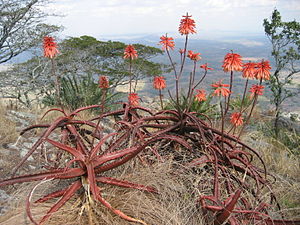Aloe cameronii
| Aloe cameronii | ||||||||||||
|---|---|---|---|---|---|---|---|---|---|---|---|---|

Aloe cameronii |
||||||||||||
| Systematics | ||||||||||||
|
||||||||||||
| Scientific name | ||||||||||||
| Aloe cameronii | ||||||||||||
| Hemsl. |
Aloe cameronii is a species of the genus Aloes in the subfamily of the Affodil family (Asphodeloideae). The epithet cameronii honors the Scot Kenneth J. Cameron who worked for the African Lakes Corporation in Malawi.
description
Vegetative characteristics
Aloe cameronii grows trunk-forming and branches out from its base. The upright trunks are up to 150 centimeters long and 3 to 4 centimeters wide. Usually they are covered with dried up leaf remnants. On the top 30 to 50 centimeters are the perennial, triangular leaves , the tips of which are pointed, and form rosettes . Their green leaf blades , which usually turn copper-red in winter , are 40 to 50 centimeters long and 5 to 7 centimeters wide. The stinging, light brown teeth on the leaf margin are 2 to 3 millimeters long and 10 to 15 millimeters apart.
Inflorescences and flowers
The inflorescence consists of two to three branches and reaches a length of 60 to 90 centimeters. The rather dense, cylindrical, slightly pointed grapes are 10 to 15 centimeters long and 7 to 8 centimeters wide. The egg-shaped-pointed bracts have a length of 2 millimeters and are 3 millimeters wide. The bright scarlet flowers are on 3 to 5 millimeter long peduncles . The occasionally slightly club-shaped flowers are 45 millimeters long and rounded at their base. At the level of the ovary , they have a diameter of 5 to 7 millimeters. Above that, the flowers are slightly expanded and slightly narrowed towards the mouth. Your outer tepals are not fused together over a length of 12 to 15 millimeters. The stamens and the style stick out about 5 millimeters from the flower.
genetics
The number of chromosomes is .
Systematics and distribution
Aloe cameronii is common in Zimbabwe , Malawi , Mozambique, and Zambia . Aloe cameronii var. Cameronii grows in Malawi, Mozambique, Zambia and Zimbabwe in shallow pockets on granite rocks at altitudes of 1280 to 2070 meters. Aloe cameronii var. Bondana is common in Zimbabwe on granite hills and Aloe cameronii var. Dedzana in Malawi and Mozambique on rocky hills.
The first description by William Botting Hemsley was published in 1903.
A distinction is made between the following varieties :
- Aloe cameronii var. Cameronii
- Aloe cameronii var. Bondana Reynolds
- Aloe cameronii var. Dedzana Reynolds
Aloe cameronii var. Bondana
The differences to Aloe cameronii var. Cameronii are: the shoots are usually simple and 60 to 180 centimeters long. The more fleshy and somewhat club-shaped flowers are usually yellowish to orange in color and 38 to 40 millimeters long.
The first description of the variety by Gilbert Westacott Reynolds was published in 1966.
Aloe cameronii var. Dedzana
In contrast to Aloe cameronii var. Cameronii , the variety grows densely shrubby, has shoots 50 to 80 centimeters long and grapes 20 to 25 centimeters long.
The first description of the variety was also made by Gilbert Westacott Reynolds and was published in 1965.
proof
literature
- Susan Carter , John J. Lavranos , Leonard E. Newton , Colin C. Walker : Aloes. The definitive guide . Kew Publishing, Royal Botanic Gardens, Kew 2011, ISBN 978-1-84246-439-7 , pp. 575-576 .
- Leonard Eric Newton: Aloe cameronii . In: Urs Eggli (Hrsg.): Succulent lexicon. Monocotyledons . Eugen Ulmer, Stuttgart 2001, ISBN 3-8001-3662-7 , pp. 121 .
Individual evidence
- ↑ Urs Eggli, Leonard E. Newton: Etymological Dictionary of Succulent Plant Names . Springer, Berlin / Heidelberg 2010, ISBN 978-3-642-05597-3 , p. 39.
- ^ Curtis's Botanical Magazine . Volume 129, 1903, plate 7915 ( online ).
- ^ Gilbert Westacott Reynolds: The Aloes of tropical Africa and Madagascar . The Trustees, Aloes Book Fund, 1966, p. 353.
- ^ Journal of South African Botany . Volume 31, Number 2, 1965, pp. 167-168.
